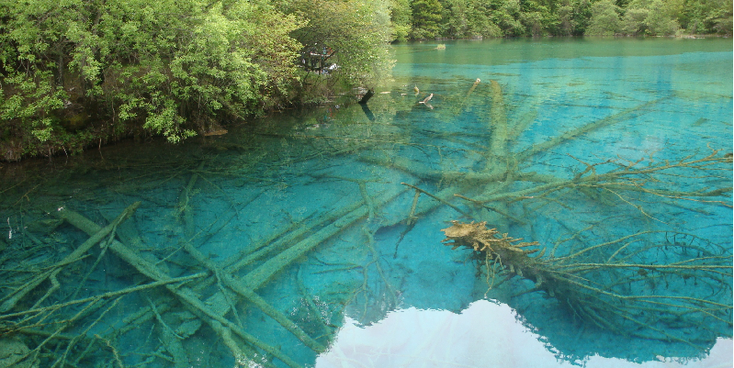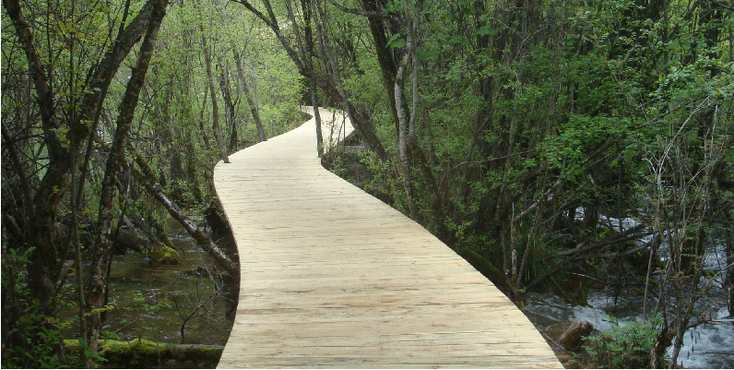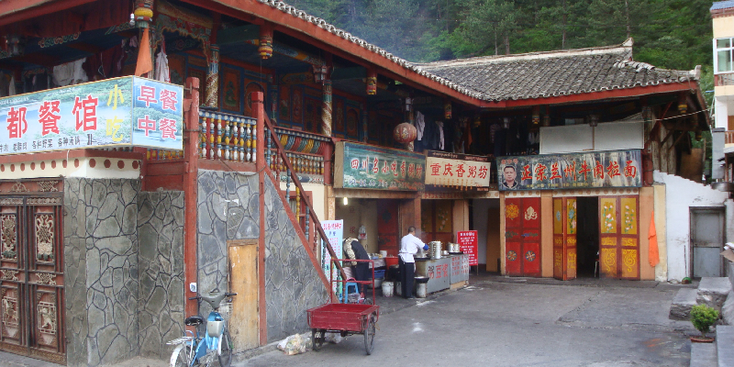Jiuzhaigou National Park
Travel Stories - China

introduction
When you’re travelling in China it’s every time a relief when you’ve found the right bus. But it’s even better when you arrive in the right place or when you meet other (Western) tourists who wants to go the same place. But just when you think this is a nice relaxed ride, the first cigarette is lit; by the driver himself, while there is a sign above his head "no smoking".
The first two hours are on big four-lane roads and the driver keeps a close eye on the speed cameras. We make big progress till we turn of the main road and suddenly drive on a much smaller back-road. If this is going to be the road for another 10 hours it’s going to be hell. When we turn into the mountains and ask if at least the fellow passengers no longer want to smoke so much, we see with our own eyes what I had already forgotten: the big earthquake of 2008!
Roads, traintracks and bridges have been demolished, fields are ploughed and thousands of Chinese people became homeless. Now it is a big chaos here; for the population thousands of blue-white containers have been set up as temporary houses and workmen are working overtime with refurbishing and restoring, roads and bridges. It is a large construction site with cranes, concrete mortar and murdering trucks that transport sand. Around it is crawling through traffic on concrete slabs and unpaved roads to leave all this behind as soon as possible.

The nine villages

The route we drive is beautiful; deep valleys, mountain passes, agricultural land covered with plastic, swirling rivers and small villages. You feel the temperature drop in the bus as you see the amount of trees are declining and the snow increases. Panoramas with snowy peaks and now almost Tibetan houses with the bright colors red, yellow, white and gray.
The road workers look more and more "oriental" and mainly consist of women! It’s starting to get dark when we arrive in Jiuzhaigou valley and I quickly get out of the bus to walk to the trunk to get my bag out and look for a hostel. Scattered in the Jiuzhaigou valley are nine villages, which give the name to the area (Jiuzhaigou means "nine villages valley"). With a lot of dust on top of my bag on my back I walk past the expensive hotels towards the entrance of the park where there should be a few affordable hostels. A boy comes to me with a calculator that has 50 on the display. Assuming this is the price, I also want to know what kind of room it is and he writes on a piece of paper "standard". It’s probably a new hostel which is always good because they need the money and customers who can tell other people about it.
The village looks "Tibetan" with all balconies, bright colors and colored drawings on the walls. The remote area was inhabited by Tibetans and Qiang for centuries. It was not until 1972 that the area was officially “discovered” by the government and wood was cut down on a large scale. This stopped in 1979 when the Chinese government banned this and designated the area in 1982 as a national park. I walk behind the boy into a luxury room and expect that he wants to show this at a higher price and then say that he also has rooms of 50Y but this is omitted.
Do I get all this for converted for 5 euros? When the boy hands the key I go looking for defects (no hot water for example) because this is too good to be true but find nothing and enjoy the evening of my super-deluxe room though it is cold because of the lack of a heater. So maybe that was the reason why the price was low.

Panda’s and Takin's

Early in the morning I walk to the entrance of the park where it is already quite busy. Because I am asked if I also want to buy a bus ticket for the park, I ask how this works but then she turns quite; probalby she’s taught to tell me what my options are in English, but when I start to ask questions it turns out that was all her English unfortunately. Luckily a Chinese man is standing behind me and picks up our conversation.
He explains to me the park is too big to see on foot and says that buses constantly drive back and forth and you can step in and out everywhere to see the highlights. I thank him and buy a ticket including a busticket. Then I take the bus all the way to the other side of the park and then take a mix of walk and bus back to the entrance.
The "Bamboo" stop is my first real stop and here I see why they call this the fairytale forest; the water is crystal clear and it appears that trees and plants simply grow further but then under water - certain minerals seem to be the cause of that unique appearance. Besides the lakes, the panorama is beautiful with snowy mountain peaks, autumnal colors in the trees and lots of pine forest. Also here seem to be panda, takin's and the golden monkeys live.
In order to avoid the big crowds a bit and to see as much as possible “live”, I try to walk as much as possible over the wooden ramps that act as footpaths between the lakes. The next lake is perhaps even more impressive than the first one I saw since the water here has a decent current because of the waterfalls. Beautiful flowers with amazing colours complete this wonderful park. The "five-color lake" betrays that it has more different colors, but with this lake even the human eye has difficulty distinguishing what is visible above and below water.
Annoying are the multitudes of Chinese who all want to have their picture taken one by one, some completely in traditional clothes and block the most views.


Jiuzhaigou NP:
In 1984 the doors of the Jiuzhaigou National Park opened for tourism and in 1987 the facilities and park”rules” were completed. In 1992 the park was recognized as a UNESCO World Heritage. In 1997 the recognition became World Biosphere Reserve. The park is famous for the colored lakes and waterfalls on different levels.
The region is inhabited by 130 Tibetan and Qiang families. Because of the protected status of the park, it is forbidden to farm for these residents. The residents live on government subsidies and tourism. The most famous endangered species that occurs in Jiuzhaigou is the Giant Panda bear. The estimated population in the park is only 17 animals, because the population is closed off from other groups of peers, it is considered to be seriously endangered.
The Giant Panda is also the name giver of the Panda-lake and the accompanying bamboo forest. Another seriously endangered species in the park is the Golden Snub-nosed Monkey, which also contains a very small number in the valley. In addition to these species, there are also the endangered Small panda, which, incidentally, is not related to the Giant Panda, but is more related to the raccoon. Other mammals include the Forest Goat Antelopes, the Witliphert, and the Chinese water-dear. In addition to the mammals there are about 140 bird species in Jiuzhaigou. Including pheasants, owl species and other birds of prey such as the eagle and the vulture.
Zechawazhai

By means of bus and on foot I zigzag the entire park until I arrive at Zechawazhai, a small Tibetan settlement in the middle of all those lakes and beautiful nature. I'm not the only one who got the idea to have lunch here and I see the only "white" tour group sitting around the picnic tables.
The rest of the tourist is Chinese which is not so strange – before I came here I never heard nobody at this place. I didn’t know it was existing. Next to that it’s very far from everything in China. This place is very pricey to eat and crowded and despite the fact that it looks great with dozens of Tibetan flags, I’m going elsewhere to eat something.
After a long day strolling through the park, I decide to go back and arrange a bus ticket for tomorrow, and that is a good thing; there is a bus going to Songpan! It is cold in my room so I decide to "eat out" and end up in a small restaurant where a group of Chinese people shuffle, spitting, smacking and gurgling behind a big bowl of noodles. Then I swam through the only street of the village back to my cold loft and read some under the warm blankets before I turn off the light.

tips & advice (2009)

The bus station is located about 3 km east of Jiuzhaigou city and it must be about one kilometer from the entrance to the national park (also east).
Jiuzhaigou - Songpan: a bus goes to Songpan at 7:30 a.m. to travel afterwords north from there (Songpan lies to the southwest). Price is 40Y and the ride takes about 2.5 hours.
see also:
LANDEN:
EUROPA:
Albanië * België * Bosnië-Herzegovina * Bulgarije * Denemarken * Duitsland * Engeland * Estland * Finland * Frankrijk * Griekenland * Hongarije * (Noord) Ierland * Italië * Kosovo * Kroatië * Letland * Litouwen * Luxemburg * Macedonië * Malta * Montenegro * NEDERLAND * Oekraïne * Oostenrijk * Polen * Portugal * Roemenië * Rusland * Schotland * Servië * Slovenië * Slowakije * Spanje * Tsjechië * Turkije * Zweden
NOORD EN CENTRAAL-AMERIKA:
Chili * Costa Rica * Cuba * Guatemala * Mexico * Nicaragua * Panama * Verenigde Staten
ZUID-AMERIKA:
Argentinië * Bolivia * Brazilië * Colombia * Ecuador * Peru
AFRIKA:
Botswana * Burkina Faso * Egypte * Ethiopië * Ghana * Kenia * Mali * Marokko * Namibië * Oeganda * Senegal * Tanzania * Tunesië * Zuid-Afrika
MIDDEN-OOSTEN:
Iran * Israël * Jordanië * V.A.E.
AZIE:
Armenië * Cambodja * China * Filipijnen * Georgië * India * Indonesië * Japan * Kirgizië * Laos * Maleisië * Mongolië * Myanmar * Nepal * Oezbekistan * Singapore * Sri Lanka * Thailand * Vietnam
OCEANIE:
Voor meer reisfoto's kijk op www.instagram.com/cheapskatetravel.nl:
© Cheapskatetravel.nl; 2018 (all rights reserved)


